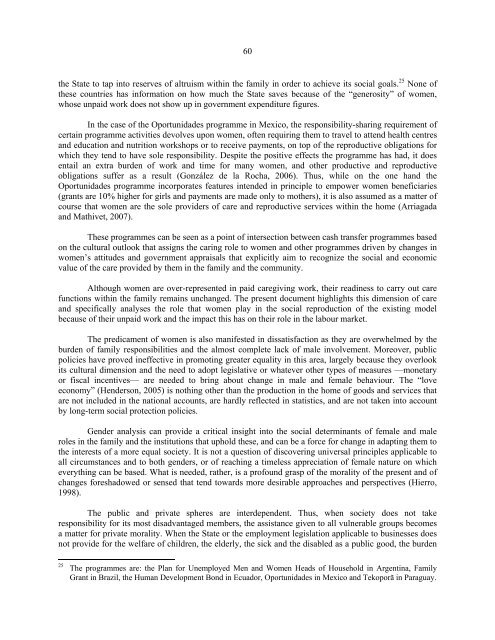Women in Latin America and the Caribbean - Cepal
Women in Latin America and the Caribbean - Cepal
Women in Latin America and the Caribbean - Cepal
Create successful ePaper yourself
Turn your PDF publications into a flip-book with our unique Google optimized e-Paper software.
60<br />
<strong>the</strong> State to tap <strong>in</strong>to reserves of altruism with<strong>in</strong> <strong>the</strong> family <strong>in</strong> order to achieve its social goals. 25 None of<br />
<strong>the</strong>se countries has <strong>in</strong>formation on how much <strong>the</strong> State saves because of <strong>the</strong> “generosity” of women,<br />
whose unpaid work does not show up <strong>in</strong> government expenditure figures.<br />
In <strong>the</strong> case of <strong>the</strong> Oportunidades programme <strong>in</strong> Mexico, <strong>the</strong> responsibility-shar<strong>in</strong>g requirement of<br />
certa<strong>in</strong> programme activities devolves upon women, often requir<strong>in</strong>g <strong>the</strong>m to travel to attend health centres<br />
<strong>and</strong> education <strong>and</strong> nutrition workshops or to receive payments, on top of <strong>the</strong> reproductive obligations for<br />
which <strong>the</strong>y tend to have sole responsibility. Despite <strong>the</strong> positive effects <strong>the</strong> programme has had, it does<br />
entail an extra burden of work <strong>and</strong> time for many women, <strong>and</strong> o<strong>the</strong>r productive <strong>and</strong> reproductive<br />
obligations suffer as a result (González de la Rocha, 2006). Thus, while on <strong>the</strong> one h<strong>and</strong> <strong>the</strong><br />
Oportunidades programme <strong>in</strong>corporates features <strong>in</strong>tended <strong>in</strong> pr<strong>in</strong>ciple to empower women beneficiaries<br />
(grants are 10% higher for girls <strong>and</strong> payments are made only to mo<strong>the</strong>rs), it is also assumed as a matter of<br />
course that women are <strong>the</strong> sole providers of care <strong>and</strong> reproductive services with<strong>in</strong> <strong>the</strong> home (Arriagada<br />
<strong>and</strong> Mathivet, 2007).<br />
These programmes can be seen as a po<strong>in</strong>t of <strong>in</strong>tersection between cash transfer programmes based<br />
on <strong>the</strong> cultural outlook that assigns <strong>the</strong> car<strong>in</strong>g role to women <strong>and</strong> o<strong>the</strong>r programmes driven by changes <strong>in</strong><br />
women’s attitudes <strong>and</strong> government appraisals that explicitly aim to recognize <strong>the</strong> social <strong>and</strong> economic<br />
value of <strong>the</strong> care provided by <strong>the</strong>m <strong>in</strong> <strong>the</strong> family <strong>and</strong> <strong>the</strong> community.<br />
Although women are over-represented <strong>in</strong> paid caregiv<strong>in</strong>g work, <strong>the</strong>ir read<strong>in</strong>ess to carry out care<br />
functions with<strong>in</strong> <strong>the</strong> family rema<strong>in</strong>s unchanged. The present document highlights this dimension of care<br />
<strong>and</strong> specifically analyses <strong>the</strong> role that women play <strong>in</strong> <strong>the</strong> social reproduction of <strong>the</strong> exist<strong>in</strong>g model<br />
because of <strong>the</strong>ir unpaid work <strong>and</strong> <strong>the</strong> impact this has on <strong>the</strong>ir role <strong>in</strong> <strong>the</strong> labour market.<br />
The predicament of women is also manifested <strong>in</strong> dissatisfaction as <strong>the</strong>y are overwhelmed by <strong>the</strong><br />
burden of family responsibilities <strong>and</strong> <strong>the</strong> almost complete lack of male <strong>in</strong>volvement. Moreover, public<br />
policies have proved <strong>in</strong>effective <strong>in</strong> promot<strong>in</strong>g greater equality <strong>in</strong> this area, largely because <strong>the</strong>y overlook<br />
its cultural dimension <strong>and</strong> <strong>the</strong> need to adopt legislative or whatever o<strong>the</strong>r types of measures —monetary<br />
or fiscal <strong>in</strong>centives— are needed to br<strong>in</strong>g about change <strong>in</strong> male <strong>and</strong> female behaviour. The “love<br />
economy” (Henderson, 2005) is noth<strong>in</strong>g o<strong>the</strong>r than <strong>the</strong> production <strong>in</strong> <strong>the</strong> home of goods <strong>and</strong> services that<br />
are not <strong>in</strong>cluded <strong>in</strong> <strong>the</strong> national accounts, are hardly reflected <strong>in</strong> statistics, <strong>and</strong> are not taken <strong>in</strong>to account<br />
by long-term social protection policies.<br />
Gender analysis can provide a critical <strong>in</strong>sight <strong>in</strong>to <strong>the</strong> social determ<strong>in</strong>ants of female <strong>and</strong> male<br />
roles <strong>in</strong> <strong>the</strong> family <strong>and</strong> <strong>the</strong> <strong>in</strong>stitutions that uphold <strong>the</strong>se, <strong>and</strong> can be a force for change <strong>in</strong> adapt<strong>in</strong>g <strong>the</strong>m to<br />
<strong>the</strong> <strong>in</strong>terests of a more equal society. It is not a question of discover<strong>in</strong>g universal pr<strong>in</strong>ciples applicable to<br />
all circumstances <strong>and</strong> to both genders, or of reach<strong>in</strong>g a timeless appreciation of female nature on which<br />
everyth<strong>in</strong>g can be based. What is needed, ra<strong>the</strong>r, is a profound grasp of <strong>the</strong> morality of <strong>the</strong> present <strong>and</strong> of<br />
changes foreshadowed or sensed that tend towards more desirable approaches <strong>and</strong> perspectives (Hierro,<br />
1998).<br />
The public <strong>and</strong> private spheres are <strong>in</strong>terdependent. Thus, when society does not take<br />
responsibility for its most disadvantaged members, <strong>the</strong> assistance given to all vulnerable groups becomes<br />
a matter for private morality. When <strong>the</strong> State or <strong>the</strong> employment legislation applicable to bus<strong>in</strong>esses does<br />
not provide for <strong>the</strong> welfare of children, <strong>the</strong> elderly, <strong>the</strong> sick <strong>and</strong> <strong>the</strong> disabled as a public good, <strong>the</strong> burden<br />
25<br />
The programmes are: <strong>the</strong> Plan for Unemployed Men <strong>and</strong> <strong>Women</strong> Heads of Household <strong>in</strong> Argent<strong>in</strong>a, Family<br />
Grant <strong>in</strong> Brazil, <strong>the</strong> Human Development Bond <strong>in</strong> Ecuador, Oportunidades <strong>in</strong> Mexico <strong>and</strong> Tekoporã <strong>in</strong> Paraguay.











